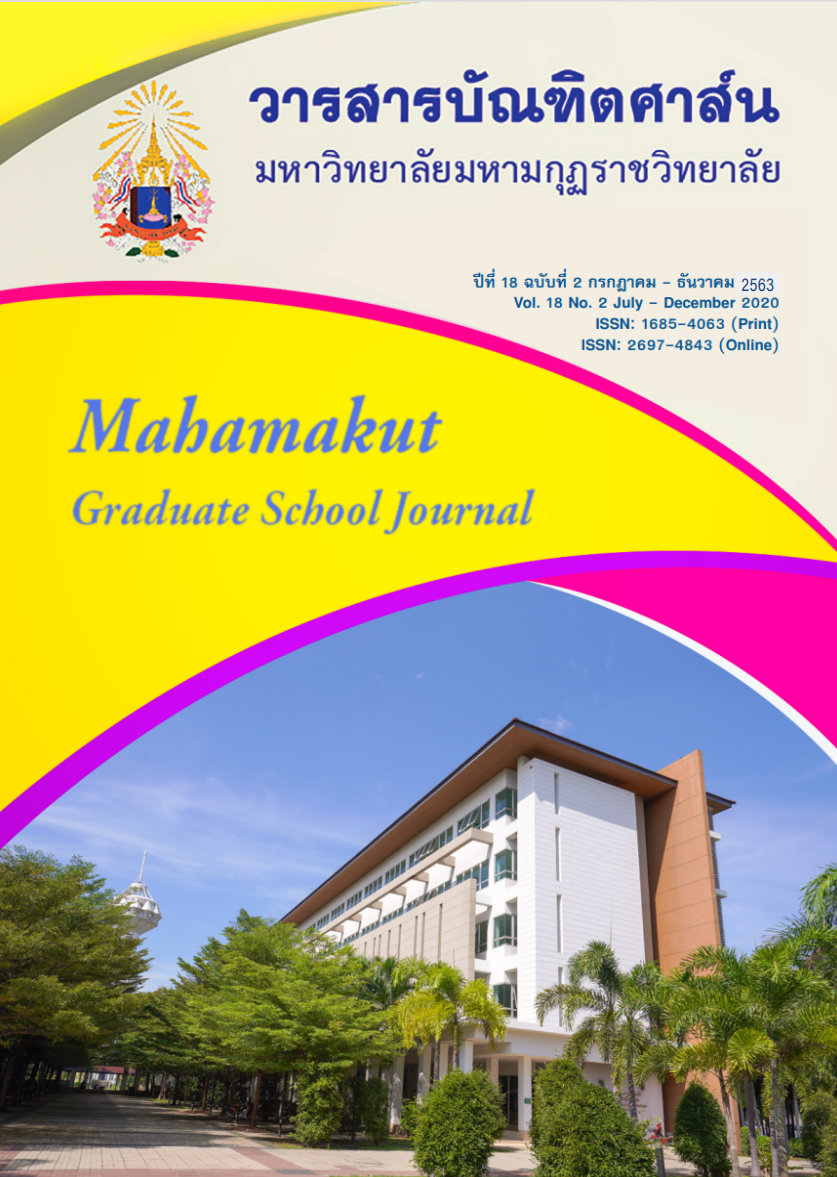โมเดลความสัมพันธ์เชิงสาเหตุความภักดีในการใช้บริการสั่งอาหารผ่านแอปพลิเคชัน ของผู้บริโภคในเขตกรุงเทพมหานครและปริมณฑล
คำสำคัญ:
แกร็บฟู้ด;, โมเดลความสัมพันธ์เชิงสาเหตุ;, ความภักดี;, การใช้บริการสั่งอาหาร;, แอปพลิเคชัน;บทคัดย่อ
งานวิจัยครั้งนี้มีวัตถุประสงค์เพื่อพัฒนาโมเดลความสัมพันธ์เชิงสาเหตุความภักดีในการใช้บริการสั่งอาหารผ่านแอปพลิเคชันของผู้บริโภคในเขตกรุงเทพมหานครและปริมณฑลและเพื่อตรวจสอบความสอดคล้องของโมเดลความสัมพันธ์เชิงสาเหตุที่พัฒนาขึ้นกับข้อมูลเชิงประจักษ์ เครื่องมือที่ใช้ในการวิจัย ได้แก่ แบบสอบถามออนไลน์ กลุ่มตัวอย่าง ได้แก่ ผู้ที่เคยใช้บริการสั่งอาหารผ่านแอปพลิเคชันแกร็บฟู้ดที่อาศัยในเขตกรุงเทพมหานครและปริมณฑล จำนวน 259 คน สถิติที่ใช้ในการวิเคราะห์ข้อมูล ได้แก่ จำนวน ร้อยละและโมเดลสมการโครงสร้างใช้ในการวิเคราะห์ความสัมพันธ์เชิงสาเหตุเพื่อหาเส้นทางอิทธิพลเชิงสาเหตุของตัวแปรประกอบด้วย 5 ตัวแปร ได้แก่
1) ด้านภาพลักษณ์ของแอปพลิเคชันแกร็บฟู้ด 2) ด้านการรับรู้คุณค่า 3) ด้านคุณภาพการบริการ 4) ด้านความ
พึงพอใจของลูกค้า และ 5) ด้านความภักดี ผลการวิจัย พบว่า โมเดลความสัมพันธ์เชิงสาเหตุที่พัฒนาขึ้นสอดคล้องกับข้อมูลเชิงประจักษ์เป็นอย่างดี ค่าสัมประสิทธิ์การพยากรณ์เท่ากับ 0.95 แสดงว่าตัวแปรในโมเดลสามารถอธิบายความแปรปรวนของความภักดีในการใช้บริการสั่งอาหารผ่านแอปพลิเคชันได้ร้อยละ 95 พบว่า ด้านความพึงพอใจของลูกค้าและด้านการรับรู้คุณค่ามีอิทธิพลมากที่สุดต่อความภักดีในการใช้บริการสั่งอาหารผ่าน
แอปพลิเคชันของผู้บริโภคในเขตกรุงเทพมหานครและปริมณฑล
เอกสารอ้างอิง
ข่าวไทยพีบีเอส. (2562). ตลาดอาหาร Delivery โตถึง 3.5 หมื่นล้าน กังวลเพิ่มขยะจากบรรจุภัณฑ์. สืบค้น 23 ตุลาคม 2562, จาก https://news.thaipbs.or.th/content/280785
ณรัณภัสสร์ ฐิติพัทธกุล. (2561). Delivery 4.0 เมื่อบริการจัดส่งเข้ามามีบทบาทสำคัญกับธุรกิจอาหาร สืบค้น 23 ตุลาคม 2562 จาก https://www.disruptignite.com/blog/delivery-impact-on-food-service.
ธานินทร์ ศิลป์จารุ. (2555). การวิจัยและวิเคราะห์ข้อมูลทางสถิติด้วย SPSS และ AMOS (พิมพ์ครั้งที่ 13). กรุงเทพฯ: บิสซิเนส อาร์แอนด์ดี.
นงลักษณ์ วิรัชชัย. (2542). โมเดลลิสเรล: สถิติวิเคราะห์สำหรับการวิจัย (พิมพ์ครั้งที่ 3). กรุงเทพฯ: โรงพิมพ์แห่งจุฬาลงกรณ์มหาวิทยาลัย.
ปณชัย อารีเพิ่มพร. (2562). เปิดกลยุทธ์ Cloud Kitchen ดัน Grab Food โต 110 เท่าใน 1 ปี 4 ล้านออร์เดอร์ใน 4 เดือน. สืบค้น 23 ตุลาคม 2562, จาก https://thestandard.co/grab-food-strategy/.
สุนิษฐา เศรษฐีธร. (2554). รายงานตลาดอาหารในประเทศไทย Thailand Food Market Report. สืบค้น 27 ตุลาคม 2562, จาก http://fic.nfi.or.th/webtour/pdf/th-food-mkt.pdf.
Grab. (2562). ยอดเงินใน GrabPay Wallet จ่ายค่าอะไรได้บ้าง.สืบค้น 20 ตุลาคม 2562,จาก https://help.grab.com/passenger/th-th/360023573092
Hossein N., Chua P. & Maryam A. (2013). Antecedents Impact on Brand Loyalty in Cosmetics Industry. Journal of Applied Sciences. 13(1), 126-132.
Yanyang L. & Napawan K. (2018). Factors Influencing Customer Satisfaction and Brand Loyalty of Top 5 Express Delivery Service in China. Retrieved 11 October 2019, From http://www.ijbejournal.com/images/files/273705bc7692734e18.pdf.
ดาวน์โหลด
เผยแพร่แล้ว
รูปแบบการอ้างอิง
ฉบับ
ประเภทบทความ
สัญญาอนุญาต
บทความวิชาการและบทความวิจัยในวารสารฉบับนี้ถือเป็นความรับผิดชอบของผู้เขียนเท่านั้น บทความที่ได้รับการตีพิมพ์ในวารสารบัณฑิตศาส์น ถือเป็นลิขสิทธิ์ของมหาวิทยาลัยมหามกุฏราชวิทยาลัย ตามพระราชบัญญัติลิขสิทธิ์



